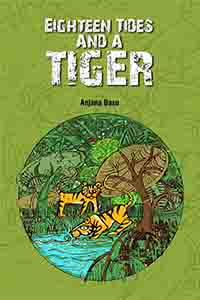“Uniting pace, a symbol of courage and along with that a character from a fairy tale to link old and new, So that a bridge is formed between the heroic, romantic traditions of the past and today’s modern world.”
NO MAJOR SPOILERS
The tale begins with an observation of man-animal conflict perceived by an adolescent. Both Basu’s forewords reflect her two passions – poetry and children! The latter she treats with amused affection and immense patience.
Her nephew Rohan’s foreword says that three people were killed by tigers in the Kumaon because “the tiger was terrified on seeing them. This is an example of man-animal conflict”. The message – here’s a story about tigers and children – and not necessarily in that order.

In the third of her Jim Corbett’s ghost series, Basu takes her protagonist, another young Rohan who is ‘almost grown up, to the Sunderbans – the land of eighteen tides and many tigers and Rohan has to stop thinking “dry footed tigers”. There are tigers aplenty – the first appears in the night on the deck of a country boat – respectfully called “mama” (uncle) by the boatmen. The second is a young tiger in distress. There are also tiger sightings, tigers stalking and scaring tourists – swimming with ease from one island to the next with scant respect for political borders!
Woven into the fabric of the story are the legends of Dakhin Rai and Bon Bibi – the fearsome tiger god and protector of the tigers – the former feared and appeased and the latter worshipped in the Sundarbans. Enter Bibi, a girl who poles a country boat at dead of night; she may be from a nearby village but then she has the skill to appear and disappear without a trace − keeping Rohan (and the readers) on tenterhooks.
There are also many stories within the tale. Tiger stories, monkey stories, account of the origins of Gosaba; and the story that Bibi tells Rohan about young Dukhi. What’s enchanting about the book is that it is told from an adolescent’s perspective.
Reviewed by:
Vijayluxmi Bose
Added 6th May 2017

